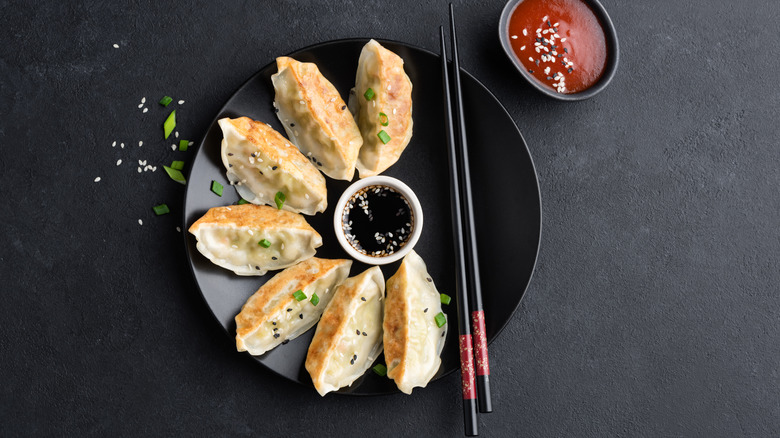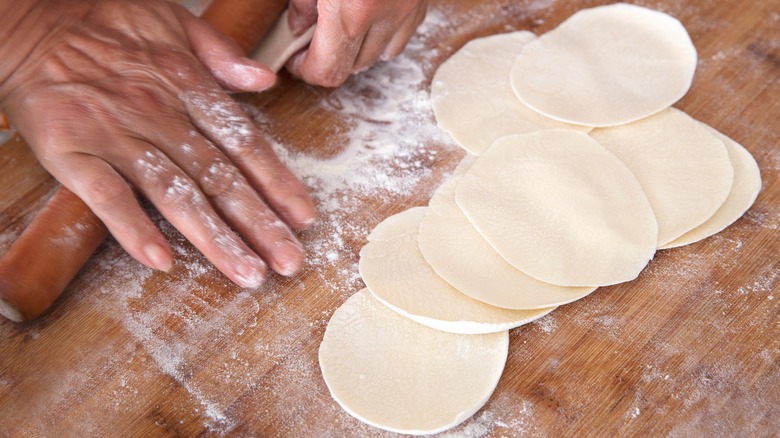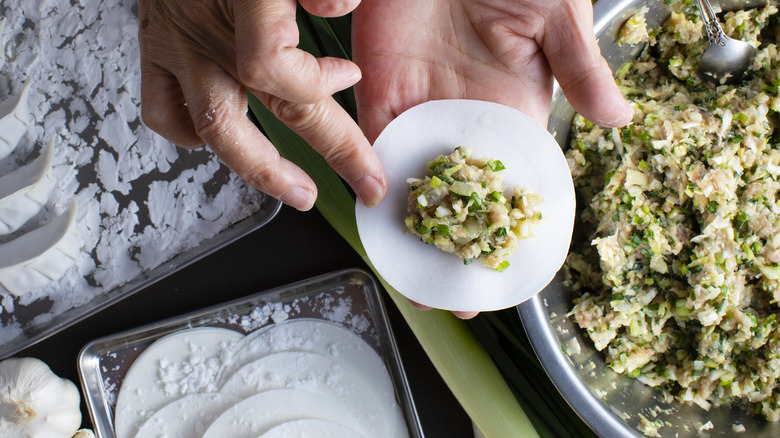The Top Tips For Making Jiaozi Wrappers From Scratch, According To An Expert
Plump and packed with savory goodness, jiaozi dumplings are a favorite for fans of Chinese cuisine. These delicious morsels contain a juicy center filled with mouth-watering meats and veggies bound by a thin layer of dough. They can be boiled, steamed, or fried and pair well with a soy or vinegar-based sauce. Jiaozi have come to symbolize prosperity and are commonly eaten during Chinese New Year celebrations.
Homemade jiaozi are the perfect dish for an appetizer or even a full meal, but they can be devilishly difficult to wrap. In an interview with the Daily Meal, veteran chef and entrepreneur Jing Gao shared her best tips for making the perfect homemade jiaozi wrappers. Gao is the founder and CEO of Fly By Jing, an online site that offers an extensive collection of Sichuan-inspired recipes, ingredients, and kitchen gadgets. When it comes to jiaozi, Gao believes a good wrapper requires a dough with the perfect texture: Firm yet soft. The essential step to achieving this texture? Letting the dough rest.
Give the dough time to sit
When making jiaozi, you'll need to roll small circles of dough and use them to envelope the fillings. To avoid torn, smooshed, or otherwise mangled dumplings, your dough must maintain a strong but flexible consistency. For optimal handling quality, Jing Gao emphasizes the importance of allowing the dough to sit. "Letting the dough rest is crucial for developing gluten," she tells the Daily Meal, "Which makes the wrappers pliable and easy to work with." After resting, your dough "should be soft yet firm enough to roll out thinly without tearing."
When the dough is ready to form, you'll want to roll all wrappers to a uniform size and circular shape. For proper sealing, Gao recommends making sure that the center of the dough "is slightly thicker than the edges." To build the dumplings, you'll place a small amount of filling in the center, fold the sides together, and crimp the thin edges of the dough to form an enclosed pocket. After crimping, the thin edges should be about the same thickness as the thicker portion of the wrapper, which will help ensure the internal ingredients are evenly cooked.
Build the ultimate jiaozi
Jiaozi has endless variation potential. Traditionally, the dumplings contain a mixture of meat and vegetables. Ground pork is a common choice, as is minced chicken, beef, shrimp, and fish. While chunks of meat will give the dumplings a hearty texture and robust flavor, they aren't strictly necessary; vegetarian dumplings will still deliver the explosion of sauce and umami taste you'd expect from perfect jiaozi. Veggies are typically shredded and usually include cabbage, carrots, and mushrooms. Aromatics, like scallions, ginger, and onions, can be added for additional flavor.
While meats and vegetables are important, jiaozi derive their signature flavor from the accompanying sauce. Dumpling sauces utilize several ingredients, but most make use of a pungent garlic kick and an umami-rich vinegar. Chili oil is a popular addition, and its spice levels can range from mild to intense depending on your taste. Soy sauce and sesame oil are also found in many recipes; the two give off salty and nutty flavors that pair extremely well with the heat of the chili oil. When completed, the dumplings should be drizzled with a healthy dose of sauce or dunked directly into dishes filled with this liquid umami blend.


